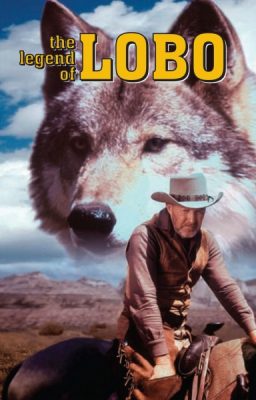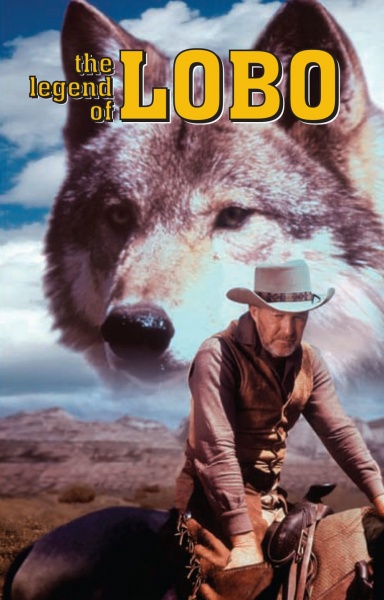
Based on Ernest Thompson Seton’s 1898 short story “Lobo the King of Currumpaw,” which was inspired by Seton’s wolf-hunting experiences in the American Southwest, Disney’s The Legend of Lobo was theatrically released on November 7, 1962. The live action nature adventure is sixty-seven minutes in length.
Plot Summary
In the late-nineteenth-century American Southwest, the native wolves deal with dangers from both animal predators and the encroaching human population, especially the cowboys (Emile Genest and Walter Pidgeon). If the wolves want to avoid extinction, they need a strong leader, and, fortunately, they have one in El Feroz, “the fierce one.” El Feroz provides for his mate and five children, including Lobo, by hunting antelope, buffalo, and cattle; by thwarting threats that arise when his children get tangled in mischief; and by relocating his family when cowboys move too close to the wolves’ previous habitation for comfort. As great a leader as El Feroz is, however, Lobo proves superior in this regard upon his father’s death. Indeed, Lobo becomes such a nuisance to the cowboys by hunting their cattle that the humans put a bounty on the wolf to hasten his demise. Will this monetary reward finally end the reign of the wolves in the region?
The Legend of Lobo’s plot is shallow. The outlaw storyline adds some excitement to the end of the movie, but this subplot develops too slowly and too late to contribute much to one’s enjoyment of the film.
Narration and Song
Although The Legend of Lobo features several human characters, the film has no dialogue. In lieu of conversations between and among the on-screen players, information is relayed to the audience by a combination of general narration from Rex Allen and a recurring ballad-style theme song, “The Legend of Lobo,” which was written by Richard and Robert Sherman and performed by the musical group “Sons of the Pioneers.”
Allen’s narration and the Sherman Brothers’ theme song are both excellent, and they are among the major reasons to recommend the film. Allen’s narration, which occurs in tandem with the movie’s visible antics, is concurrently folksy, soothing, and witty, presented in a style akin to that of a grandfather telling a story to his grandchildren. For its part, “The Legend of Lobo” is an extremely catchy number, comparable to, though perhaps not quite as good as, the ballad from Disney’s Davy Crockett series of the 1950s. “The Legend of Lobo,” which is alternately soothing and exciting and which will linger in your head for a while after watching the flick, is representative of the best work of Richard and Robert Sherman. The Sherman Brothers, who contributed music to numerous other Disney films, including Summer Magic (1963), Mary Poppins (1964), The Happiest Millionaire (1967), The One and Only, Genuine, Original Family Band (1968), The Aristocats (1970), Bedknobs and Broomsticks (1971), and The Many Adventures of Winnie the Pooh (1977), were named Disney Legends in 1990; Rex Allen was named a Disney Legend in 1996.
Nature
With great vistas of natural beauty, plenty of animal shenanigans, and no dialogue, The Legend of Lobo is a more sophisticated version of the installments of Walt Disney’s “True-Life Adventures” series, a string of thirteen nature-based films released by the Disney Studio between Seal Island in 1949 and Jungle Cat in 1960. (1) The main difference between the “True-Life Adventures” installments and The Legend of Lobo is the discernable plot in the latter; as such, The Legend of Lobo is for all intents and purposes one of Disney’s “True-Life Fantasy” films. Although only Perri (1957) officially garnered this label, other films, including Nikki, Wild Dog of the North (1961) and The Incredible Journey (1963), followed a similar formula, incorporating an overt story and oftentimes human characters in addition to the antics of nature. (2) Since 2007, Disney has released a series of nature-based documentaries under the “Disneynature” label.
Numerous animals are incorporated in The Legend of Lobo. These critters include wolves, buffalo, antelope, cougars, turtles, porcupines, badgers, rattlers, raccoons, cattle, and dogs.
The opening scene of The Legend of Lobo, where buffalo rumble across the landscape with the theme song soothingly playing in the background, is beautiful to behold. A similar vibe of beauty is maintained throughout the film with the varied terrain types and colors of the American Southwest frequently displayed.
Leadership
Throughout The Legend of Lobo, the title critter works to become a leader, proverbially grabbing life by the horns rather than merely going with the flow. From the time he is six weeks old, Lobo demonstrates independence, frequently wandering off the trail and, in one telling scene, taking the initiative to walk behind his mother rather than waiting for his mother to carry him like she does Lobo’s siblings. Lobo’s independent nature occasionally endangers the wolf, but these moments of peril afford Lobo experience and wisdom that can only be learned from taking risks. In human terms, Lobo is eschewing theoretic knowledge from book-learning for practical knowledge from real-life experience. As Rex Allen says early in the film, “The school of hard knocks isn’t a bad place to start an education. And Lobo caught on fast. The truth was, all of his life, he’d be one to learn from experience, and what’s more important, store it up and remember it.”
Loyalty
Rex Allen notes early in the film that wolves are loyal critters; they “mate for life, the male and the female both being devoted to each other and the family.” Said loyalty is demonstrated throughout the movie, most notably in the flick’s closing moments, when Lobo devises an ingenious scheme to free his mate from the clutches of a bounty hunter.
Action
Action scenes are interspersed throughout The Legend of Lobo. Along the way, a herd of buffalo and a herd of cattle march across open terrain, El Feroz hunts antelope to feed his family, the wolves and a pair of hunters battle a cougar, El Feroz battles a badger for the latter’s den, El Feroz rescues Lobo from a snake, Lobo runs and swims with a new antelope friend, the hungry wolves fight cattle, Lobo fights for leadership of a new pack of wolves, and the wolves attempt to survive the growing human presence. The growing human presence sets the stage for a climactic battle scene, where Lobo and his pack rescue Lobo’s mate from a bounty hunter, who is using the female wolf as bait to capture the wanted title character. The excitement of this fight is enhanced by a long rendition of the film’s theme song.
Humor
No aspects of The Legend of Lobo are hysterically funny, but Rex Allen’s witty narration and the corresponding on-screen action will likely provide a few chuckles.
After Lobo wanders off for the first time, Allen says, “Well, if you’re going to leave your common sense at home when you go travelling, you’re bound to land in trouble.” Moments later, Lobo does land, tumbling a few feet below onto a pile of grass and rocks.
With the wolves preparing to move to a new den after the cougar incident, Allen puts words in El Feroz’s mouth concerning the animal’s mate: “All right dear; get a move on; let’s get going.”
Allen refers to the wolves’ quest to find a new den as “house hunting.”
Lobo stops to “say howdy” to a turtle and follows the turtle down its path. After a while, Lobo finally gets “the point” that the turtle does not want company—the turtle hides under a cactus, and Lobo gets poked in the nose by the prickly plant.
Relationship to Other Disney Films
Rex Allen subsequently narrated The Incredible Journey and Charlie, the Lonesome Cougar (1967) for Disney.
Emile Genest also appeared in Nikki, Wild Dog of the North, Big Red (1962), and The Incredible Journey for Disney.
Walter Pidgeon also contributed to Big Red and Rascal (1969) for Disney.
The American Southwest is also the setting for Ten Who Dared (1960) and Scandalous John (1971).
In The Legend of Lobo, young Lobo makes a temporary friendship with an antelope, a critter that should be a wolf’s prey. Surprising friendships between animals are also formed in Nikki, Wild Dog of the North, The Incredible Journey, A Tale of Two Critters (1977), and The Fox and the Hound (1981).
Cowboys also play important roles in the “El Gaucho Goofy” segment of Saludos Amigos (1942), in the “Pecos Bill” segment of Melody Time (1948), and in Tall Tale (1995). “Sons of the Pioneers” also contributed music to the Pecos Bill short.
In the Parks
Guests wanting accommodations themed after the American Southwest should consider lodging at Walt Disney World’s “Coronado Springs Resort,” Disneyland Resort Paris’s “Disney’s Hotel Cheyenne,” and Disneyland Resort Paris’s “Disney’s Hotel Santa Fe.”

The American West is the theme for the respective “Frontierland” sections at Walt Disney World’s Magic Kingdom and the Disneyland Parks in California and Paris. The “Westernland” section at Tokyo Disneyland Park and the “Grizzly Gulch” section at Hong Kong Disneyland Park have a similar theme.
The Sherman Brothers contributed songs to many classic Disney theme park attractions, including “It’s a Small World,” “Journey into Imagination with Figment,” “Walt Disney’s Carousel of Progress,” and “Walt Disney’s Enchanted Tiki Room.”
Overall
The Legend of Lobo is a good family film. The plot is loose, but the animal antics, the relaxing narration, and the theme song make the effort worth watching.
Notes
1) Jim Korkis, “Walt and the True-Life Adventures,” The Walt Disney Family Museum, February 9, 2012, accessed September 27, 2018, https://www.waltdisney.org/blog/walt-and-true-life-adventures.
2) Ibid.
What do you think of The Legend of Lobo? Let me know in the comments!
Did you like this article? Make sure to share it with your friends! Check below for easy ways to share!
Want to visit Walt Disney World? Contact The Magic for Less Travel for more information and a free, no-obligation quote.
Incoming search terms:
- porcupines wolfs bridge kids movie
- The Legend of Lobo


